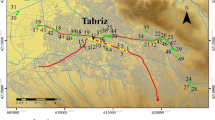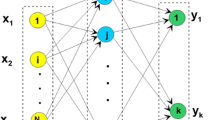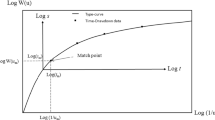Abstract
Hydraulic conductivity is the essential parameter for groundwater modeling and management. Yet estimation of hydraulic conductivity in a heterogeneous aquifer is expensive and time consuming. In this study; artificial intelligence (AI) models of Sugeno Fuzzy Logic (SFL), Mamdani Fuzzy Logic (MFL), Multilayer Perceptron Neural Network associated with Levenberg–Marquardt (ANN), and Neuro-Fuzzy (NF) were applied to estimate hydraulic conductivity using hydrogeological and geoelectrical survey data obtained from Tasuj Plain Aquifer, Northwest of Iran. The results revealed that SFL and NF produced acceptable performance while ANN and MFL had poor prediciton. A supervised intelligent committee machine (SICM), which combines the results of individual AI models using a supervised artificial neural network, was developed for better prediction of the hydraulic conductivity in Tasuj plain. The performance of SICM was also compared to those of the simple averaging and weighted averaging intelligent committee machine (ICM) methods. The SICM model produced reliable estimates of hydraulic conductivity in heterogeneous aquifers.




Similar content being viewed by others
References
Abkav Consulting Engineering Company (1973) Geophysical studies reports of Tabriz, Tasuj and Shabestar plains. East Azerbaijan Regional Water Authority, Persian
Akbari M, Afshar A, Sadrabadi MR (2009) Fuzzy rule based models modification by new data: application to flood flow forecasting. Water Resour Manag 23(12):2491–2504
Akrami SA, Shafie A, Jaafar O (2013) Improving rainfall forecasting efficiency using modified adaptive neuro-fuzzy inference system (MANFIS). Water Resour Manag 27(9):3507–3523
Anifowose F, Abdulraheem A (2011) Fuzzy logic-driven and SVM-driven hybrid computational intelligence models applied to oil and gas reservoir characterization. J Nat Gas Sci Eng 3(3):505–517
Aqil M, Kita I, Yano A, Nishiyama S (2007) Analysis and prediction of flow from local source in a river basin using a neuro-fuzzy modeling tool. J Environ Manag 85(1):215–223
Arrell KE, Fisher PF, Tate NJ, Bastin L (2007) A fuzzy c-means classification of elevation derivatives to extract the morphometric classification of landforms in Snowdonia, Wales. Comput Geosci 33:1366–1381
ASCE Task Committee on Application of Artificial Neural Networks in Hydrology (2000) Artificial neural network in hydrology, part I and II. J Hydrol Eng 5:115–137
Bárdossy A, Disse M (1993) Fuzzy rule-based models for infiltration. Water Resour Res 29(2):373–382
Batyrshin I, Sheremetov L, Markov M, Panova A (2005) Fuzzy rule-based models for infiltration hybrid method for porosity classification in carbonate formations. J Pet Sci Eng 47:35–50
Calvo PI, Estrada GJC (2009) Improved irrigation water demand forecasting using a soft-computing hybrid model. Biosyst Eng 102(2):202–218
Chen CH, Lin ZS (2006) A committee machine with empirical formulas for permeability prediction. Comput Geosci 32:485–496
Chiu S (1994) Fuzzy model identification based on cluster estimation. J Intell Fuzzy Syst 2:267–278
Chu HJ, Chang LC (2009) Application of optimal control and fuzzy theory for dynamic groundwater remediation design. Water Resour Manag 23(4):647–660
Colin F, Guillaume S, Tisseyre B (2011) Small catchment agricultural management using decision variables defined at catchment scale and a fuzzy rule-based system: a Mediterranean vineyard case study. Water Resour Manag 25(11):2649–2668
Daliakopoulos IN, Coulibaly P, Tsanis IK (2005) Groundwater level forecasting using artificial neural networks. J Hydrol 309:229–240
Dhar A, Patil RS (2012) Multiobjective design of groundwater monitoring network under epistemic uncertainty. Water Resour Manag 26(7):1809–1825
Fijani E, Chitsazan N, Nadiri AA, Asghari MAA, Tsai, FTC (2012) Hierarchical bayesian model averaging for non-uniqueness and uncertainty analysis of artificial neural networks. AGU Fall Meeting, San Francisco, USA
Garcia LA, Shigidi A (2006) Using neural networks for parameter estimation in groundwater. J Hydrol 318(1–4):215–231
Gaur S, Ch S, Graillot D, Chahar BR, Kumar DN (2013) Application of artificial neural networks and particle swarm optimization for the management of groundwater resources. Water Resour Manag 27(3):927–941
Haykin S (1999) Neural networks, a comprehensive foundation. Macmillan College Publishing, New York
Helmy T, Fatai A, Faisal K (2010) Hybrid computational models for the characterization of oil and gas reservoirs. Expert Syst Appl 37(7):5353–5363
Hornik K, Stinchcombe M, White H (1989) Multilayer feedforward networks are universal approximators. Neural Netw 2:359–366
Huang Y, Gedeon TD, Wong PM (2010) An integrated neural-fuzzy-genetic-algorithm using hyper-surface membership functions to predict permeability in petroleum reservoirs. Eng Appl Artif Intell 14(1):15–21
Hurtado N, Aldana M, Torres J (2009) Comparison between neuro-fuzzy and fractal models for permeability prediction. Comput Geosci 13:181–186
Inan T, Tayfur G (2012) A prediction model for the level of well water. Sci Res Essays 7(50):4242–4252
Kadkhodaie-Ilkhchi A, Rezaee MR, Rahimpour-Bonab H (2009) A committee neural network for prediction of normalized oil content from well log data: An example from south pars gas field, Persian Gulf. J Pet Sci Eng 65:23–32
Kannan SR, Ramathilagam S, Chung PC (2012) Effective fuzzy c-means clustering algorithms for data clustering problems. Expert Syst Appl 39:6292–6300
Labani MM, Kadkhodaie-Ilkhchi A, Salahshoor K (2010) Estimation of NMR log parameters from conventional well log data using a committee machine with intelligent systems: A case study from the Iranian part of the south pars gas field, Persian Gulf Basin. J Pet Sci Eng 72:175–185
Li H, Philip CCL, Huang HP (2001) Fuzzy neural intelligent systems: Mathematical foundation and the applications in engineering. CRC Press, Boca Raton
Lim JS (2005) Reservoir properties determination using fuzzy logic and neural networks from well data in offshore Korea. J Pet Sci Eng 49:182–192
Malki HA, Baldwin J (2002) A neuro-fuzzy based oil/gas producibility estimation method. IEEE Int Jt Conf Neural Netw 1:896–901
Mamdani EH (1976) Advances in the linguistic synthesis of fuzzy controllers. Int J Man Mach Stud 8:669–678
Mamdani EH (1977) Applications of fuzzy logic to approximate reasoning using linguistic synthesis. IEEE Trans Comput 26:1182–1191
Mamdani EH, Assilian S (1975) An experimental in linguistic synthesis with a fuzzy logic control. Int J Man Mach Stud 7:1–13
Merdun H, Inar OC, Meral R, Apan M (2006) Comparison of artificial neural network and regression pedotransfer functions for prediction of soil water retention and saturated hydraulic conductivity. Soil Tillage Res 90:108–116
Mohanty S, Jha MK, Kumar A, Sudheer KP (2010) Artificial neural network modeling for groundwater level forecasting in a River Island of Eastern India. Water Resour Manag 24(9):1845–1865
Moosavi V, Vafakhah M, Shirmohammadi B, Behnia N (2013) A Wavelet-ANFIS hybrid model for groundwater level forecasting for different prediction periods. Water Resour Manag 27(5):1301–1321
Morankar DV, Raju KS, Kumar DN (2013) Integrated sustainable irrigation planning with multiobjective fuzzy optimization approach. Water Resour Manag 27(11):3981–4004
Motaghian HR, Mohammadi J (2011) Spatial estimation of saturated hydraulic conductivity from terrain attributes using regression, kriging, and artificial neural networks. Pedosphere 21(2):170–177
Mustafa MR, Rezaur RB, Saiedi S, Isa MH (2012) River suspended sediment prediction using various multilayer perceptron neural network training algorithms—A case study in Malaysia. Water Resour Manag 26(7):1879–1897
Nadiri AA (2007) Water level evaluation in Tabriz underground area by artificial neural networks. MS Theses, University of Tabriz, Iran
Nadiri AA, Asghari MAA, Tsai FTC, Fijani E (2013) Hydrogeochemical analysis for Tasuj plain aquifer, Iran. J Earth Syst Sci 122(4):1091–1105
Naftaly U, Intrator N, Horn D (1997) Optimal ensemble averaging of neural networks. Comput Neural Syst 8:283–296
Nayak PC, Rao YRS, Sudheer KP (2006) Groundwater level forecasting in a shallow aquifer using artificial neural network approach. Water Resour Manag 20(1):77–90
Nourani V, Asgharimogaddam A, Nadiri A, Sing VP (2008a) Forecasting spatiotemporal water levels of Tabriz Aquifer. Trend Appl Sci Res 3(4):319–329
Nourani V, Asgharimogaddam A, Nadiri AA (2008b) An ANN-based model for spatiotemporal groundwater level forecasting. Hydrol Process 22:5054–5066
Olatunji SO, Selamat A, Abdulraheem A (2011) Modeling the permeability of carbonate reservoir using type-2 fuzzy logic systems. Comput Ind 62:147–163
Piotrowski AP, Napiorkowski JJ (2011) Optimizing neural networks for river flow forecasting – Evolutionary computation methods versus the Levenberg–Marquardt approach. J Hydrol 407:12–27
Putvance DT (2000) On the electrical-hydraulic conductivity correlation in aquifers. Water Resour Res 36(10):2905–2913
Research Center of Agriculture and Natural Resources of East Azerbaijan Province (2010) Annual report of water balance of Tasuj plain (in Persian)
Ross J, Ozbek M, Pinder GF (2007) Hydraulic conductivity estimation via fuzzy. Math Geol 39(8):765–780
Safavi HR, Chakraei I, Samani AK, Golmohammadi MH (2013) Optimal reservoir operation based on conjunctive use of surface water and groundwater using neuro-fuzzy systems. Water Resour Manag 27(12):4259–4275
Samani N, Gohari-Moghadam M, Safavi AA (2007) A simple neural network model for the determination of aquifer parameters. J Hydrol 340:1–11
Sanikhani H, Kisi O (2012) River flow estimation and forecasting by using two different adaptive neuro-fuzzy approaches. Water Resour Manag 26(6):1715–1729
Schaap MG, Leij FJ (1998) Using neural networks to predict soil water retention and soil hydraulic conductivity. Soil Tillage Res 47:37–42
Sezer A, Göktepe AB, Altun S (2010) Adaptive neuro-fuzzy approach for sand permeability estimation. Environ Eng Manag J 9(2):231–238
Shirmohammadi B, Vafakhah M, Moosavi V, Moghaddamnia A (2013) Application of several data-driven techniques for predicting groundwater level. Water Resour Manag 27(2):419–432
Siou LK, Johannet A, Borrell V, Pistre S (2011) Complexity selection of a neural network model for karst flood forecasting: the case of the Lez Basin (southern France). J Hydrol 403:367–380
Sugeno M (1985) Industrial application of fuzzy control. North-Holland, New York
Sulaiman M, Shafie A, Karim O, Basri H (2011) Improved water level forecasting performance by using optimal steepness coefficients in an artificial neural network. Water Resour Manag 25(10):2525–2541
Sun J, Zhao Z, Zhang Y (2011) Determination of three dimensional hydraulic conductivities using a combined analytical/neural network model. Tunn Undergr Space Technol 26:310–319
Takagi T, Sugeno M (1985) Identification of systems and its applicationto modeling and control. IEEE Trans Syst Man Cybern 15:116–132
Tamari S, Wosten JHM, Ruiz-Suarez JC (1996) Testing an artificial neural network for predicting soil hydraulic conductivity. Soil Sci Soc Am J 60(6):1732–1741
Tayfur G (2012) Soft computing in water resources engineering. WIT Press, Southampton
Tayfur G, Singh VP (2011) Predicting mean and bankfull discharge from channel cross-sectional area by expert and regression methods. Water Resour Manag 25(5):1253–1267
Tayfur G, Moramarco T, Singh VP (2007) Predicting and forecasting flow discharge at sites receiving significant lateral inflow. Hydrol Process 21(14):1848–1859
Tsai FTC, Li X (2008) Multiple parameterization for hydraulic conductivity identification. Groundwater 46(6):851–864
Tutmez B (2010) Assessment of porosity using spatial correlation-based radial basis function and neuro-fuzzy inference system. Neural Comput Appl 19:499–505
Tutmez B, Hatipoglu Z (2007) Spatial estimation model of porosity. Comput Geosci 33:465–475
Wolkenhauer O (2001) Fuzzy mathematics in systems theory and data analysis. John Wiley & Sons, New York, USA
Zadeh LA (1965) Fuzzy sets. Inf Control 8:338–353
Zounemat-Kermani M, Teshnehlab M (2008) Using adaptive neuro-fuzzy inference system for hydrological time series prediction. Appl Soft Comput 8(20):928–936
Author information
Authors and Affiliations
Corresponding author
Rights and permissions
About this article
Cite this article
Tayfur, G., Nadiri, A.A. & Moghaddam, A.A. Supervised Intelligent Committee Machine Method for Hydraulic Conductivity Estimation. Water Resour Manage 28, 1173–1184 (2014). https://doi.org/10.1007/s11269-014-0553-y
Received:
Accepted:
Published:
Issue Date:
DOI: https://doi.org/10.1007/s11269-014-0553-y




